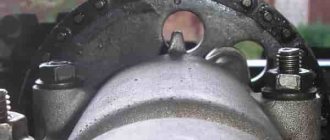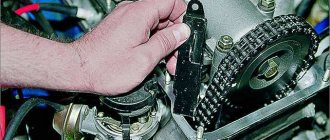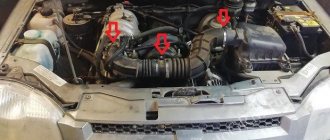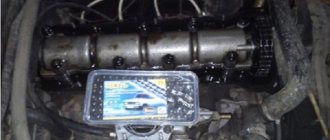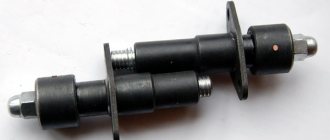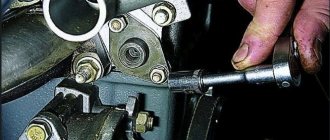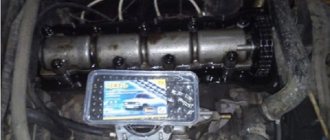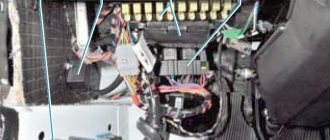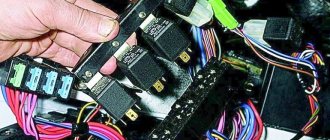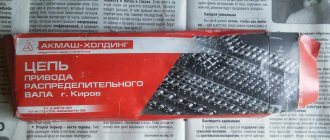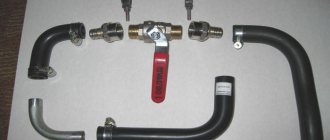Hydraulic chain tensioner. The genuine pain of the domestic auto industry
Hydraulics, as you know, is a science that loves precision. The diameters of holes and bushings are ideally adjusted to microns, valves work reliably like clockwork and high requirements for the purity and quality of the working fluid (in our case, oil). Alas, when it comes to cheap domestic spare parts, the path to hell is paved with good intentions, such as the use of a progressive hydraulic tensioner for Lada 4x4 engines.
It would seem like a finely tuned automatic system. No periodic adjustments or diagnostics for you: the plunger reliably self-locks at working cut-offs until chain wear increases and additional force becomes necessary to tension it. Alas, when it comes to domestic spare parts, all this is good only in theory.
The principle of operation of the hydraulic tensioner on Niva
Without once again venting in angry odes towards the domestic automobile industry, we will simply summarize that the problem of extraneous noise from the internal combustion engine, the main cause of which is often the hydraulic chain tensioner on the VAZ 21214, exists and we have to deal with it somehow. And, as we know, there is no smoke without fire, and another common problem with the hydraulic chain tensioning system is the failure of the oil-conducting system. Killed by running a dry internal combustion engine sounds like a bad dream. What to do and how to continue to live?
conclusions
As you can see, to carry out this work you do not need to have any special knowledge or tools. Therefore, you can handle this kind of work yourself if necessary . If you follow these recommendations, it is impossible to carry out such repairs incorrectly.
The part designed to regulate the chain tension in a Niva Chevrolet car is called a timing belt (gas distribution mechanism) hydraulic tensioner. In the Chevrolet Niva timing system, the hydraulic tensioner performs a very important function, so engine operation without such a part is simply impossible. Over time, all parts of a car tend to wear out. Rotating parts of cars are especially prone to wear, weakening, stretching and breaking. This part includes the timing chain, which stretches over time and wears out. Chain stretching is normal but must be addressed. It is to eliminate chain stretch that a hydraulic tensioner is installed in the timing system. It has a wear property that is detected by loosening the chain to half the sprocket tooth.
Replacing the hydraulic chain tensioner on Niva
The new model Nivki, which is better known to us as the Chevrolet Niva, cutting through domestic roads, inherited the above-mentioned disease from its older brother, the VAZ 21214, which, in turn, is now proudly called Lada 4x4. But the problem is not as scary as its description. In order to keep the power unit in good condition, it is enough to always keep your finger on its pulse: listen to extraneous sounds, regularly carry out maintenance after 60-100 thousand kilometers and not let the problem take its course.
Preparatory work
In order to create the necessary space to carry out work, you will have to perform a number of actions.
- Remove the air filter and close the carburetor neck with a plug.
- Disconnect the choke cable, electrical wire, and hoses. We move them to the side.
- Remove the fan, pump pulley and generator belt.
- We remove the sump protection and the engine boot, and clean the front engine cover.
- Now you need to put the Chevrolet Niva on the parking brake and place wheel chocks under the wheels. Then engage fourth gear. Now let's start the analysis.
- Loosen the ratchet nut by striking the wrench sharply with a hammer.
- Remove the valve cover, bend the lock washer of the camshaft gear bolt, loosening it by hitting the wrench with a hammer. Turn off transmission.
- Rotate the crankshaft pulley, align the marks on it and the front engine cover, and then align the marks on the camshaft gear and bearing housing.
ORDER CHIP TUNING OF YOUR CAR RIGHT NOW!
Leave an online request for the service and we will contact you to clarify details
Content:
general information
It has long been known that the quality of car parts produced at the AvtoVAZ plant is not of a high level. And timing parts are no exception. The chain has to be constantly tightened, almost every thousand kilometers. A hydraulic chain tensioner will help get rid of this problem. It is this device that we will talk about in this article. Let's look in detail at the operation scheme and replacement of the device.
Scheme of work
The figure below shows a diagram of the operation of the spring-hydraulic chain tensioner of the VAZ 21214 car. 1 – camshaft star; 2 – timing chain; 3 – chain damper; 4 – auxiliary device drive star; 5 – crankshaft star; 6 – tensioner “shoe”; 7 – hydraulic chain tensioner; 8 – line fitting; 9 – oil line; 10 – adapter fitting; 11 – oil pressure sensor (emergency).
We invite you to read the detailed instructions:
- Unscrew the tube fitting using a spanner. Remove the tube, otherwise it will interfere with further work.
- Now unscrew the two nuts securing the hydraulic tensioner.
- Remove the device from its seat. Pull out the gasket together with the hydraulic tensioner - it needs to be replaced with a new one.
- Be sure to replace the device with a new one; it cannot be repaired. Check whether the design of the new hydraulic tensioner is identical to the old used model. Before installing it, coat the gasket with sealant. This must be done in order to avoid oil leakage.
- Secure the installed device with two fastening nuts.
- Now insert the tube and secure it.
As you can see, everything is quite simple. You don’t have to worry about doing something wrong, because you simply won’t be able to install the hydraulic tensioner incorrectly. After installation, be sure to check how the motor works, as well as the tension of the new chain.
After reading this article, you, dear motorists, now know how to reinstall the hydraulic tensioner without going to a service station. If your car has traveled more than a hundred thousand kilometers, it is necessary to check the chain tension, even if no characteristic sounds were noticed.
Source: ladaautos.ru
Chevrolet Niva 2010, 80 l. With. — self-repair
This system consists of the following elements: If it is damaged or worn out, vibrations appear, which can lead to the chain jumping and thereby damaging the motor.
Replacement To replace, you will need a ten-size socket wrench and a screwdriver. When the tool is ready, we carry out the following steps: GNC - hydraulic chain tensioner, a standard design that ensures tension of the chain due to the hydraulics of the tensioner; or rather, the chain tensions the shoe, which in turn is deflected by the tensioner. The disadvantage of the design is that when starting from a cold state, until the oil is pumped up and creates the necessary pressure, the tensioner rod is often easily pushed through and the timing chain at such a moment is not tensioned strongly enough, as a result of which the chain vibrates and over time breaks the damper; it is located on the chain branch opposite from the GNC The timing chain, called the leading branch of the chain.
Driving with a broken damper is fraught with serious consequences - at high speeds, the loosely tensioned chain moves so much that the chain can simply jump several teeth on the sprocket, which will lead to mismatched operation of the crankshaft and camshaft and, as a result, inconsistent operation of the valves with the cylinders.
In the worst case, the valves become bent. The way out of this situation is to install a mechanical automatic chain tensioner ANC.
The mechanics are devoid of the disadvantages of hydraulics and, with the correct design, can increase the reliability of this timing gear assembly. All automatic chain tensioners are built on the same principle - their rod extends automatically as the chain stretches, which allows you to automatically select chain slack.
On the inside of the housing walls there are spiral notches that have an inclined shape. When the chain is loosened, the piston, under pressure in the housing, moves to a certain notch on the housing wall.
When the tension occurs, the body notches do not allow the piston to take its original position. It is carried out by engaging the piston rings with one-sided notches. This is how the tension device works. How is the hydraulic tensioner replaced on a Chevrolet Niva?
We invite you to read the detailed instructions:
- Unscrew the tube fitting using a spanner. Remove the tube, otherwise it will interfere with further work.
- Now unscrew the two nuts securing the hydraulic tensioner.
- Remove the device from its seat. Pull out the gasket together with the hydraulic tensioner - it needs to be replaced with a new one.
- Be sure to replace the device with a new one; it cannot be repaired. Check whether the design of the new hydraulic tensioner is identical to the old used model. Before installing it, coat the gasket with sealant. This must be done in order to avoid oil leakage.
- Secure the installed device with two fastening nuts.
- Now insert the tube and secure it.
As you can see, everything is quite simple. You don’t have to worry about doing something wrong, because you simply won’t be able to install the hydraulic tensioner incorrectly. After installation, be sure to check how the motor works, as well as the tension of the new chain.
After reading this article, you, dear motorists, now know how to reinstall the hydraulic tensioner without going to a service station. If your car has traveled more than a hundred thousand kilometers, it is necessary to check the chain tension, even if no characteristic sounds were noticed.
Source: ladaautos.ru
Adjusting the timing chain according to marks
In the Chevrolet Niva gas distribution system there are marks presented in the form of notches and holes and placed on the timing pulleys.
The chain must be aligned precisely according to these marks for better fixation and support of the entire gas distribution mechanism. Otherwise, the pulleys will not work smoothly and will wear out much faster. This is why installation with strict adherence to labels is so important. The chain may also become loose or stretched, causing the timing system to malfunction.
To correctly align the timing chain when replacing it in a Chevrolet Niva, you need to rotate the crankshaft until the marks on the camshaft gear and the bearing align. If the marks on the crankshaft and on the chain cover match, then the drive is installed correctly. If the notches do not match, the phases must be adjusted. The mark is oblong - this makes it easier to align.
We recommend
To adjust the phase position in a Chevrolet Niva, you should disconnect the lock washer fasteners, and then unscrew the bolt from the camshaft gear with a 13 mm wrench. Next, the gearshift lever is moved to the first gear position. This will lock the crankshaft gear mounting bolt and prevent it from turning. Then this bolt must be unscrewed and removed along with the lock washer.
It should be taken into account that this bolt will not be fixed after performing these operations; accordingly, it may fall into the engine sump. Therefore, work should be performed with a wrench with a deep head.
Then, if necessary, the tensioner is removed. If there is no need to replace this element, the chain can be removed by pressing the plunger with a screwdriver. Next, the chain drive should be slightly pulled towards you to remove it from the crankshaft sprocket.
The timing drive is adjusted and set according to marks, for which it needs to be moved by one tooth. When replacing the timing belt on a Chevrolet Niva, it is more convenient to install a sprocket with the chain already on. It is required that the holes in the timing chain line up with the locating pin. This is achieved by turning the crankshaft in the desired direction until the notches coincide.
Next, install the lock washer. The mounting bolt should be tightened, but not tightened. Then you need to check if the marks match. To do this, the Chevrolet Niva crankshaft is turned with the appropriate key 2-3 times. When all the notches match, the adjustment process can be considered complete. Otherwise, all operations are repeated from the beginning.
Despite the apparent complexity, the entire adjustment process requires a little time. It is important to ensure that the marks on the timing belt of the Chevrolet Niva match. The operation of the engine will depend on this. In addition, you need to change the gasket when installing the valve cover, because when you remove the old gasket, it may develop microscopic cracks through which lubricant will leak.
VAZ specialists answer
VAZ SPECIALISTS ANSWER
EVGENY BAYBORIN - engine development department ALEXEY KLIMENKO - transmission development department
YURY PROKHOROV – after-sales service department
ALEXANDER GUSEV – transmission development department
The dampers used in the factory configuration, produced by JSC "Plastik" from Chelyabinsk, have proven to be quite reliable. In your case, the reasons for the breakdown of the original, factory damper could be factors such as an error in the initial installation, a deviation in the location of the damper mounting on the cylinder head, or the dimensions of the damper itself from the requirements of the drawing. In these cases, the damper may become distorted, ultimately leading to its destruction.
A serious threat of breakage of the damper also arises when shock loads are applied to it due to insufficient tension of the operating chain - usually this is due to a malfunction of the hydraulic tensioner, but in some cases the cause of this is excessive wear of the sprockets and chain, its significant elongation and sagging.
Calcifiers bought in a store may be inferior in strength to the original ones due to the low quality of their material - plastic.
I want to remake the VAZ-21214 timing drive according to the 21213 model. What is the difference between sprockets, chains, etc.?
The 21213 engine has a 21213 camshaft, which is driven by the long-established traditional double-row bushing chain 2103 (116 links). Here is the original kit - tensioner, shoe, chain guide. The stars are, accordingly, double-row. The number of teeth for all engine options is the same: 19 on the crankshaft nose, 38 on the camshaft and oil pump drive. Valve lever supports are mechanical. These details are well known to many from VAZ classic cars.
On the 21214 engine, to reduce noise and at the same time increase reliability, they used a single-row, but bush-roller chain 21214 (116 links), single-row sprockets, a camshaft 21214, hydraulic supports for valve levers, an original set - a hydraulic tensioner, a shoe, and a damper.
Conversion of the timing drive 21214 to 21213 is possible provided that the above parts are completely replaced, but the meaning of the event is questionable.
Theoretically, the probability of valves contacting the pistons on the 21124 engine still exists, but compared to its predecessor 2112, it is small. For such an event to occur, the following factors must confluence:
— unfavorable combination of the true dimensions of parts within tolerances;
— high engine operating temperature;
- camshaft stop when the valve is fully open.
Neither during factory tests nor in operation (starting from October 2004) were there any cases of contact of valves with pistons on VAZ-21124 engines.
